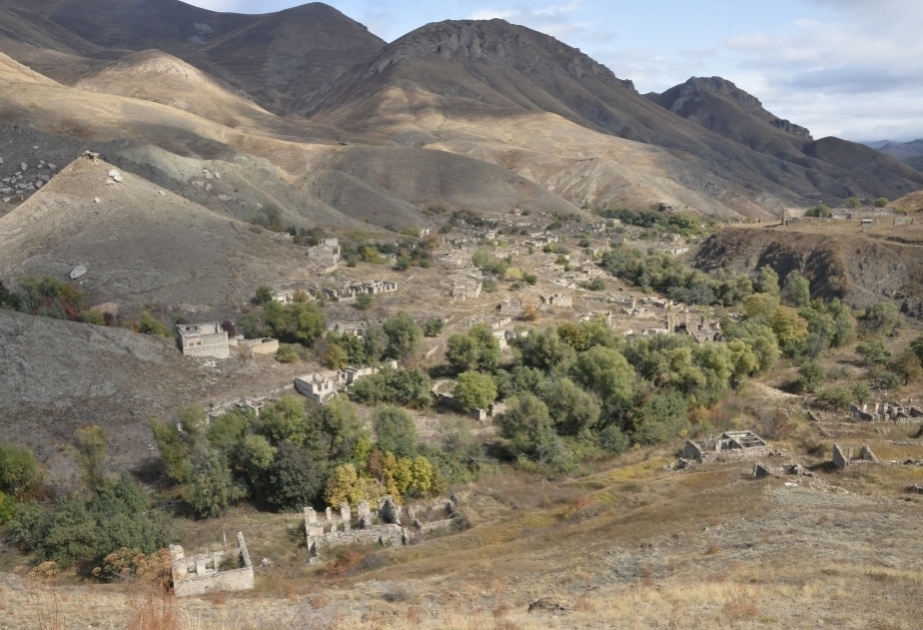
The policy of ethnic cleansing, genocide, and aggression deliberately carried out by Armenian nationalists against our people in the last 200 years is responsible for very painful stages in our history full of tragedies, including massacres. The primary goal of this nationalist and chauvinistic policy was to expel Azerbaijanis from their historical lands and create a fictitious state of “great Armenia” in the ancient territories of Azerbaijan. One of the atrocities perpetrated by Armenians against our people occurred in the village of Bashlibel during the occupation of the Kalbajar district in April 1993. Today, 31 years pass since that tragedy.
In early April 1993, after the occupation of Kalbajar by Armenians, 62 residents of the district’s Bashlibel village that had a population of about 2,000 people, could not leave their homes in time and retreated from the advancing enemy into the mountains. They managed to hide there in the caves for only 18 days. On April 18, after discovering the location of the caves where village residents had found shelter, the Armenians launched an armed attack on them, killing 18 people and taking 14 prisoner.
Thirty survivors managed to break out of the Armenian army siege through secret mountain paths only after 113 days, moving only at night. All historical, cultural and religious sites of Bashlibel, one of the oldest and largest villages of the Kalbajar district, were destroyed during the occupation.
Over these years, the government of Azerbaijan has kept the issue of investigating and studying the Bashlibel tragedy in the spotlight. In 2017, a book entitled “The Bashlibel Tragedy: Armenian Atrocities in the Language of Witnesses” was published by the State Agency for Support of Non-Governmental Organizations of the Republic of Azerbaijan as part of the same-named project. The publication, released in Azerbaijani and English languages, contains memories of witnesses to the Bashlibel massacre, as well as those who made great sacrifices to save the besieged. Information about the Bashlibel tragedy was also included in the 2021 country reports on human rights practices by the U.S. Department of State's Bureau of Democracy, Human Rights, and Labor.
After Azerbaijan regained its state independence, the opportunity arose to reveal the objective picture of the nation’s historical past and the grave consequences of the genocidal policy committed by Armenia against our people for two hundred years with the help of its patrons. In order to convey the truth about these acts of genocide to the world, the state of Azerbaijan began to take all necessary steps. Consistent activities in this field commenced after Great Leader Heydar Aliyev returned to political power in Azerbaijan. On March 26, 1998, the Presidential Decree “On the Genocide of the Azerbaijanis” was signed to mark all the genocide tragedies committed against our people. This paved the way for legal and political assessment to be given to the horrific genocides and tragedies against Azerbaijanis.
Successfully continuing and developing this policy under the leadership of Victorious Commander-in-Chief, President Ilham Aliyev, our nation achieved a remarkable Victory in the Patriotic War that began in September 2020. The answer to all the crimes the Armenians committed against our people throughout history was given in the 44-day Patriotic War and the anti-terror operation carried out in September 2023. The Azerbaijani Army avenged victims of the genocide and our martyrs on the battlefield and forced the enemy to sign an act of capitulation. Thus, the Kalbajar district was liberated from the enemy without a single shot being fired and without loss of life. The Master Plan for the construction of Kalbajar has been approved, and extensive construction is currently underway there.
Armenian chauvinists have served the fascist ideology and always been hostile to Azerbaijani and Turkish people. They have committed mass murders and acts of genocide against our people at different times. As we turn the pages of history, new facts and scenes of Armenian brutality come to light. The search for information has recently expanded, helping to obtain irrefutable archival documents and ample evidence confirming acts of genocide and other Armenian crimes. In particular, in February 2021, a mass grave of seven people was found in the village of Dashalti of the Shusha district. In April 2021, such a cemetery was found in Bashlibel, in March 2022 remains of corpses were discovered in the village of Farrukh of the Khojaly district. In September 2022, remains of 18 people were found in the village of Edilli of the Khojavand district in a mass grave. On February 21 of this year, in the center of the city of Khojaly (near the former carpet factory), a massive burial of human remains was discovered during excavation as part of restoration and construction work there.
All these facts, as well as the lack of any information about nearly 4,000 Azerbaijanis who went missing during the First Karabakh War, are evidence of the crimes against humanity committed by Armenians. For these crimes, Armenian vandals and terrorists will definitely be held to account by the international court of justice.
Views: 40
